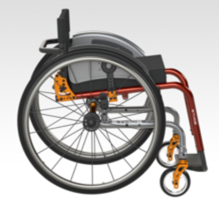What We Will Be Covering
- What is an ultralight manual wheelchair?
- Clinical Guidelines
- Configuration
- Propulsion techniques
- Case Study
Thank you to everyone for taking the time to attend this course. I do hope that it is helpful to you as well as helpful to the clients whom you serve. Today, we are going to be talking about wheelchair mobility, specifically ultralight wheelchairs. This is one type of manual wheelchair.

Figure 1. Ki Mobility Ethos.
We are going to get into some details about how these can be configured and how we can best instruct users on how to propel them in order to increase efficiency and decrease their risk of injury and pain. This is what we are going to be covering in this particular course. We are going to define an ultralight manual wheelchair in the context of other wheelchair frame options. We are then going to discuss clinical guidelines for the use of ultralight manual wheelchairs. And, for whom are these appropriate? How are they configured to best meet an individual's needs? What are our most efficient and optimal propulsion techniques? Finally, we will finish up with a detailed case study.
SMS Series
- This is part of a series of webinars designed to prepare the participant for the Seating and Mobility Specialist examination.
- And… develop more advanced seating and wheeled mobility skills
This particular course here is part of a series of webinars and is designed to prepare you for the Seating and Mobility Specialist examination. This is a certification that is available through the Rehabilitation Engineering and Assistive Technology Society of North America or RESNA. They have two certifications, the ATP, or assistive technology professional, as well as the SMS. Whether or not this is a certification that you are interested in, I certainly hope that this series will help you to develop more advanced seating and mobility skills.
Manual Wheelchairs
- A manual wheelchair is designed to provide dependent or independent mobility to a client, as well as support an appropriate seating system.
Let's talk for a minute about manual wheelchairs. A manual wheelchair as opposed to a power wheelchair is generally lighter and designed for self-propulsion, though some of these are better designed for self-propulsion than others. For instance, there are manual wheelchairs used for those that have dependent mobility and requires a caregiver to push. A manual wheelchair is designed to provide either dependent or independent mobility to a client, as well as support in an appropriate seating system. These chairs can support quite a wide variety of seating systems and a variety of sizes.
Assessment
- Assessment is typically done with a wheelchair supplier.
- Lightweight, Ultra Lightweight, and Pediatric manual wheelchairs are considered Complex Rehab equipment.
- Complex Rehab is typically recommended by a professional who is certified:
- ATP: Assistive Technology Professional
- SMS: Seating and Mobility Specialist
- These are obtained through RESNA
- Rehab Engineering and Assistive Technology Society of North America
When assessing a client for a manual wheelchair, this is typically done with a wheelchair supplier. The supplier is somebody who participates in the evaluation and is very familiar with equipment options. They will submit all the necessary paperwork to achieve funding approval for the recommended equipment. Once the funding is secured, the equipment is ordered and then fitted to the client. During this entire process, the supplier is a very critical player.
Lightweight, ultra lightweight and pediatric manual chairs are under the umbrella of complex rehab equipment. Complex rehab equipment is typically recommended by a professional who is certified. The supplier most likely will have a certification called the ATP, Assistive Technology Professional. Medicare, in particular, and some other funding sources require that if complex rehab is being recommended that the supplier has to have their ATP, or they are not allowed to participate in the process. Always keep in mind that if you are looking at a manual chair in one of these categories you need to be working with an ATP. While a clinician can have their ATP, the supplier still needs to have that ATP certification as well.
Considerations
When we are assessing someone to determine the optimal manual mobility base for them, there are a number of considerations that we need to keep in mind.
- Considerations include:
- Strength, range of motion, muscle tone and orthopedic status
- Cardiopulmonary status and fatigue
- Potential for change in function or size
- Positioning needs
- Environmental needs
We have to examine and assess the client's available strength, for example, for self-propulsion and even for transfers. Their range of motion, muscle tone, and orthopedic status are going to impact their required seating needs. And, depending on the seating system required, this could impact the wheelchair frame configuration. If this client has to sit at a particular angle at the hips, knees, or ankles, we may have to consider a very specific frame for that purpose.
We need to assess cardiopulmonary status and fatigue or try to get that information from the medical team. Part of our assessment when looking at a chair that could be self-propelled is whether this client is able to safely self-propel it. We may choose an ultralight manual wheelchair over say a lightweight manual chair in order to decrease the energy expenditure of the client.
We also need to keep in mind the potential for change in function or size. If this person has a progressive condition that can impact their future equipment needs, we have to keep that at mind. And if this is a person who is growing or gaining weight, we need to make sure that the chair can accommodate this.
We also need to look at positioning needs as this is going to determine the type of seating system that is going to be within the frame.
Lastly, there are environmental needs. Where is this person going to be using this manual wheelchair? Is it primarily indoors on level smooth surfaces? Does this family have thick carpeting in the house? Is the client going to be outdoors? Is it a rural area or are there mostly pristine sidewalks with built-in ramps at each corner?
